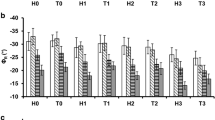Summary
This paper reports the results of two series of experiments. In the first the effects of DIHB on the rate of root elongation were compared on unstressed roots and on roots stressed by mechanical impedance and by inadequate levels of aeration. Barley plants were grown in beds of small glass spheres through which nutrient solution was circulated. Mechanical impedance of 25 kPa was applied by subjecting the beds to a confining pressure. Inadequate aeration was obtained by reducing the oxygen concentration in the nutrient solution to 5%.
The second series examined possible effects of DIHB on the elastic modulus of root tips of wheat and pea. Elastic modulus gives an indication of the behaviour of roots in structured soil where penetration of peds can be limited by the buckling of root tips. The elastic modulus was measured in experiments of the static cantilever type on roots previously immersed in solutions of polyethylene glycol of different osmotic potential. Elastic modulus measurements can also detect any changes in turgor pressure and wilting characteristics of roots and can therefore help to identify the mechanisms of action of DIHB.
DIHB caused increases in root elongation relative to controls in all cases: 26±5.7% in unstressed roots, 14±6.4% in mechanically impeded roots and 54±9.8% in roots growing in 5% oxygen. DIHB had no effect on the elastic modulus, osmotic or turgor pressure of the roots. It is concluded that DIHB acts by modifying the cell wall extensibility factor.
Similar content being viewed by others
References
Carpenter K, Cottrell H J, de Silva W H, Heywood B J, Leeds W G, Rivett K F and Soundy M L 1964 Chemical and biological properties of two new herbicides—ioxynil and bromoxynil. Weed Res. 4, 175–179.
Eisinger W, Croner L J and Taiz L 1983 Ethylene induced lateral expansion in etiolated pea stems. Plant Physiol. 73, 407–412.
Goss M J 1977 Effects of mechanical impedance on root growth in barley (Hordeum vulgare L.). I. Effects on the elongation and branching of seminal root axes. J. Exptl. Bot. 28, 96–111.
Greacen E L and Oh J S 1972 Physics of root growth. Nature (New Biology) 235(53), 24–25.
Green P B 1968 Growth physics in Nitella: a method for continuous in vivo analysis of extensibility based on a micro-manometer technique for turgor pressure. Plant Physiol. 43, 1169–1184.
Green P B, Erickson R O and Buggy J 1971 Metabolic and physical control of cell elongation rate. Plant Physiol. 47, 423–430.
Jackson M B, Dobson C M, Herman B and Merryweather A 1984 Modification of 3,5-diiodo-4-hydroxybenzoic (DIHB) activity and stimulation of ethylene production by small concentration of oxygen in the root environment. Plant Growth Regulation 2, 251–262.
Larque-Saavedra A, Wilkins H and Wain R L 1975 Promotion of cross root elongation in white light by 3,5-diiodo-4-hydroxybenzoic acid. Planta 126, 269–272.
Lawlor D W 1970 Absorption of polyethylene glycols by plants and their effects on plant growth. New Phytol. 69, 501–513.
Lockhart J A 1959 A new method for the determination of osmotic pressure. Am. J. Bot. 46, 704–708.
Macklon A 1962 The Soil-Plant-Atmosphere System: a study of water relations. Ph.D. thesis, University of Aberdeen.
Nilsson S B, Hertz C H and Falk S 1958 On the relation between turgor pressure and tissue rigidity. II. Theoretical calculations on model systems. Physiologia Plantarum 11, 818–837.
Robert M L, Taylor H F and Wain R L 1975 Ethylene production by cress roots and excised cress root segments and its inhibition by 3,5-diiodo-4-hydroxybenzoic acid. Planta 126, 273–284.
Saini G R 1979 Root elongation and plant growth in a basal till compact soil treated with 3,5-diiodo-4-hydroxybenzoic acid and gibberellic acid. Agron. J. 71, 1067–1070.
Van't Hof J and Ying H K 1964 Relationship between the duration of the mitotic cycle, the rate of cell production and the rate of growth ofPisum roots at different temperatures. Cytologia 29, 399–406.
Wain R L 1977 Root growth inhibitors.In Plant Growth Regulation. P-E Pilet (ed), pp 109–114, Berlin, Springer.
Whiteley G M and Dexter A R 1981 Elastic response of the roots of field crops. Physiol. Plant. 51, 407–417.
Wilkins S M, Wilkins H and Wain R L 1976 Chemical treatment of soil alleviates effects of soil compaction on pea seedling growth. Nature (London) 259, 392–394.
Zaki M A, Taylor H F and Wain R L 1967 Studies with 3,5-diiodo-4-hydroxybenzonitrile (ioxynil) and related compounds in soils and plants. Ann. Appl. Biol. 59, 481–491.
Author information
Authors and Affiliations
Rights and permissions
About this article
Cite this article
Goss, M.J., Dexter, A.R. & Evans, M. Mechanics of root elongation and the effects of 3,5-diiodo-4-hydroxybenzoic acid (DIHB). Plant Soil 99, 211–218 (1987). https://doi.org/10.1007/BF02370868
Received:
Revised:
Issue Date:
DOI: https://doi.org/10.1007/BF02370868




